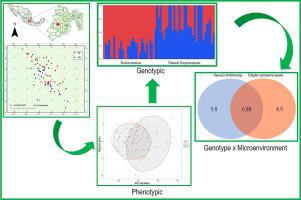Forest Ecology and Management ( IF 3.7 ) Pub Date : 2021-05-04 , DOI: 10.1016/j.foreco.2021.119293 Sebastián Arenas , Julio Campo , Alicia Mastretta-Yanes , Juan Pablo Jaramillo-Correa

|
Within-population phenotypic variation can be used as a proxy for adaptive potential and individual performance in forest plantations and natural populations. Such variation can be viewed as the sum of genetic factors and their interaction with environmental variation (e.g., soil characteristics), which lead identical genotypes to produce contrasting phenotypes in different environments, and introduced individuals to perform differently from local trees in plantations and test trials. Predicting this variation is of great interest to foresters working with commercially important species. Such is the case of sacred fir (Abies religiosa), a species that is an important source of wood and resin for communities living above 2500 m asl in central Mexico. We determined the contribution of both genetic and soil factors for predicting phenotypic performance of local naturally regenerated (NR) and introduced by reforestation (RF) seedlings in a sacred fir trial test performed by local communities in the Nevado de Toluca National Park. In spite of a low genetic differentiation between plant sources, NR seedlings outperformed RF plants in terms of height, diameter and water use. According to our models, a large part of these differences could be explained by the interaction of genetic, management and edaphic factors within the trial site, with local genotypes using more efficiently the available soil nitrogen than the introduced ones; thus indicating that planting could be changing plant microenvironment and have a measurable phenotypic effect. Association studies between genetic and edaphic variation further suggested that local adaptation might also be occurring at small within-population scales. All such traits, when correctly integrated, may result in fair genome-based phenotypic predictions for small secluded natural populations, which could be at the base of better reforestation practices, and conservation and assisted migration programs.
中文翻译:

种群内基因型–在墨西哥中部正在恢复的杉木林中,土壤相互作用驱动表型变异
种群内表型变异可以用作适应性潜力和森林人工林和自然种群中个体表现的替代指标。可以将这种变异视为遗传因素及其与环境变异(例如土壤特性)的相互作用的总和,这些变异导致相同的基因型在不同的环境中产生不同的表型,并导致个体在人工林和测试试验中的表现不同于当地树木。预测这种变化对于从事具有重要商业意义的树种的林业工作者非常有用。神圣的冷杉就是这种情况(冷杉(Abies religiosa)),该物种是居住在墨西哥中部2500 m asl以上的社区重要的木材和树脂来源。我们确定了遗传因素和土壤因素对预测当地自然再生(NR)表型表现的贡献,并通过内华达·德·托卢卡国家公园当地社区进行的神圣冷杉试验,由造林(RF)幼苗引入。尽管植物来源之间的遗传分化程度较低,但在高度,直径和用水方面,NR幼苗的表现均优于RF植物。根据我们的模型,这些差异的很大一部分可以通过试验地点内的遗传,管理和营养因子之间的相互作用来解释,与当地基因型相比,利用引入的土壤氮更有效地利用了土壤氮素;因此表明种植可能会改变植物的微环境,并具有可测量的表型效应。遗传和进化差异之间的关联研究进一步表明,局部适应性也可能在小规模的人口规模内发生。如果正确整合了所有这些特征,可能会为偏僻的自然小种群带来基于基因组的公平表型预测,这可能是更好的造林实践,保护和辅助移民计划的基础。











































 京公网安备 11010802027423号
京公网安备 11010802027423号